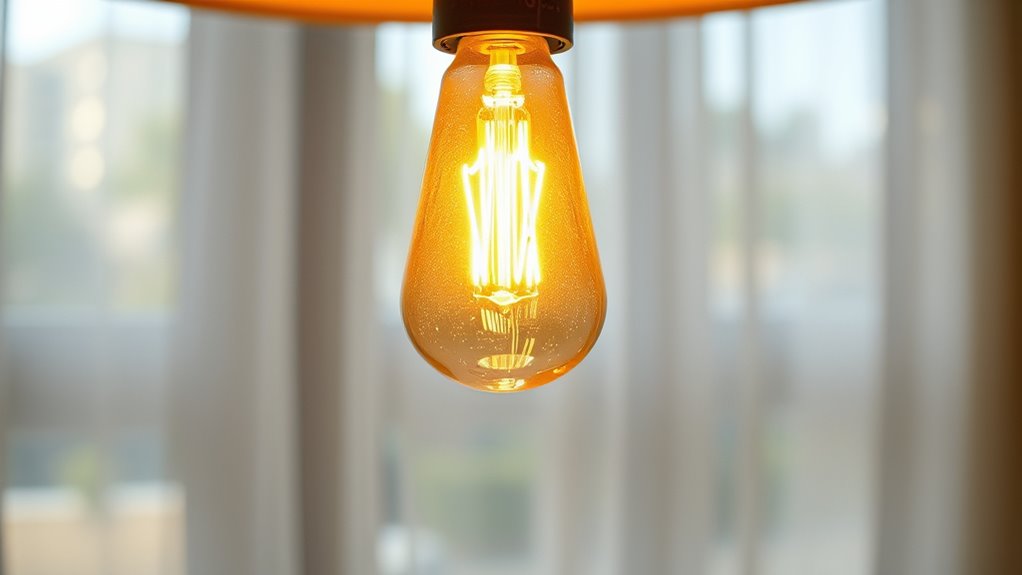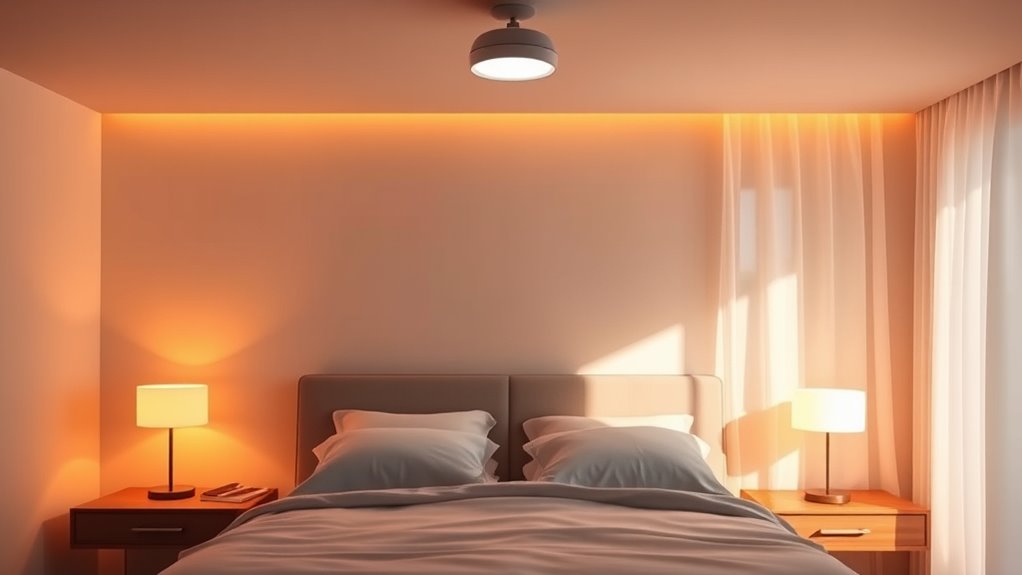To align your lighting with your circadian rhythms, get plenty of natural sunlight in the morning to boost alertness, and use bright artificial light or light therapy boxes if needed. In the evening, dim or warm lighting helps signal your body to wind down and produce melatonin. Incorporate dimmer switches to adjust brightness easily and plan your environment to support consistent sleep and wake times. Keep exploring these tips for better sleep and overall well-being.
Key Takeaways
- Use bright, natural light or light therapy in the morning to reset your internal clock and boost alertness.
- Minimize exposure to blue light and screens at least one hour before bedtime to support melatonin production.
- Incorporate warm, dim lighting in the evening to create a calming environment and signal winding down.
- Maintain a consistent sleep and wake schedule daily, including weekends, to regulate your circadian rhythm.
- Adjust indoor lighting with dimmers and smart systems to mimic natural light patterns throughout the day.
Understand Your Body’s Natural Light Needs

To effectively align your lighting with your circadian rhythms, you first need to understand your body’s natural light needs. Light exposure plays a vital role in regulating your internal clock, helping you stay alert during the day and relax at night. Recognizing when your body naturally seeks light and darkness allows you to optimize your environment for circadian alignment. For example, getting adequate daylight during the day boosts mood and alertness, while reducing exposure to artificial light at night signals your body to prepare for sleep. By paying attention to your body’s responses, you can adjust your lighting habits to support a healthier sleep-wake cycle, ensuring your circadian rhythm stays in sync with natural light patterns. Incorporating light therapy during the day can also help reinforce your body’s natural cycles and improve overall well-being.
Use Bright Light in the Morning

Using bright light in the morning is one of the most effective ways to reset your internal clock and promote alertness throughout the day. Incorporate sunrise alarms into your morning routine to ensure you wake up gradually with natural light, mimicking sunrise and signaling your brain that it’s time to start the day. Exposure to bright light shortly after waking helps suppress melatonin, making you feel more alert and focused. Make it a habit to spend at least 20-30 minutes in natural sunlight or use a light therapy box if outdoors isn’t an option. Consistent morning light exposure aligns your circadian rhythm, improving sleep quality and daytime energy. Additionally, choosing a projector with high contrast ratio can enhance visual clarity, especially in darker viewing environments, further enriching your home entertainment experience. Adjust your routine as needed to maximize the benefits of morning brightness for better overall health.
Minimize Bright Light Exposure in the Evening

After reaping the benefits of morning light exposure to start your day, it’s equally important to limit bright light in the evening to support your circadian rhythm. Bright light exposure in the evening can cause evening darkness to be disrupted, making it harder for your body to produce melatonin naturally. Melatonin suppression occurs when your eyes detect light, signaling your brain that it’s still daytime. To promote healthy sleep, dim the lights as your day winds down. Use low-intensity lamps or candles to create a calming environment. Avoid screens and bright electronic devices at least an hour before bed. This simple step helps your body recognize it’s time to wind down, ensuring melatonin levels rise and your sleep cycle stays aligned with natural rhythms. Incorporating light management techniques can further enhance your sleep quality and overall well-being.
Choose Light Bulbs That Mimic Natural Light

Choosing light bulbs that mimic natural light can make a big difference in your daily rhythm. Pay attention to color temperature, brightness levels, and options for dynamic lighting to match your needs. These features help create a healthier, more aligned environment throughout the day. Incorporating best lighting options can further enhance your circadian alignment and overall well-being.
Color Temperature Matters
Since the color temperature of your light bulbs can considerably impact your circadian rhythms, selecting bulbs that mimic natural daylight is essential. The right color temperature influences your body’s internal clock by affecting the light spectrum you’re exposed to. For daytime, aim for bulbs with a higher color temperature (around 5000-6500K), which emit a bluish-white light similar to natural sunlight. In contrast, warmer tones (around 2700-3000K) promote relaxation in the evening. Understanding the light spectrum helps you choose bulbs that support alertness during the day and relaxation at night. Here’s a quick comparison:
| Color Temperature | Effect on Circadian Rhythms |
|---|---|
| 2700K-3000K | Promotes relaxation, evening |
| 4000K-5000K | Neutral, daytime alertness |
| 6500K+ | Mimics daylight, activity time |
Additionally, choosing the appropriate lighting can help reinforce your natural sleep-wake cycle light spectrum, supporting overall health and well-being.
Brightness Levels Control
To support your circadian rhythms, selecting light bulbs with appropriate brightness levels is essential. Light intensity impacts how your body perceives day and night, influencing sleep and alertness. Look for bulbs that offer brightness control, allowing you to adjust the light to match natural lighting patterns. During the day, brighter lights with higher light intensity help energize you and mimic sunlight. In the evening, dimmer settings promote relaxation and prepare your body for sleep. Using bulbs with adjustable brightness ensures you can tailor your environment to your daily schedule. Avoid overly harsh or too dim lighting, as both can disrupt your circadian rhythm. Proper brightness control creates a natural lighting experience, supporting your sleep-wake cycle and overall well-being. Incorporating dimmable lighting options can further enhance your ability to customize your lighting environment seamlessly.
Dynamic Lighting Options
Opting for light bulbs that mimic natural light can substantially enhance your circadian health. Smart lighting systems offer dynamic options that adjust throughout the day, aligning with your body’s natural rhythms. These bulbs can change color temperature and brightness automatically, providing a realistic simulation of natural sunlight. You can set customizable scenes to brighten your mornings with energizing light and dim or warm your evenings for relaxation. This flexibility helps regulate melatonin production and improves sleep quality. Additionally, AI in Business is increasingly being used to optimize lighting environments for health benefits. By integrating smart lighting into your space, you create an environment that supports your circadian cycle, promoting overall well-being. Dynamic lighting options give you control and adaptability, making it easier to maintain healthy sleep-wake patterns and boost your daily energy levels.
Incorporate Warm Lighting During Nighttime

Incorporating warm lighting during nighttime can considerably support your circadian rhythms by reducing blue light exposure, which can interfere with melatonin production. Warm lighting creates a calming nighttime ambiance, helping your body recognize that it’s time to wind down. Instead of bright, cool-toned lights, opt for soft, amber or red hues that emit less blue light. This type of lighting helps signal to your brain that it’s evening, promoting natural melatonin release and preparing you for restful sleep. Using warm lighting consistently in the evening not only fosters relaxation but also minimizes disruptions to your circadian clock. Additionally, choosing lighting modifications designed to reduce blue light can further enhance your sleep quality. By intentionally choosing warm lighting, you support your body’s internal rhythm and improve your overall sleep quality.
Limit Screen Time Before Bed

Reducing screen time before bed complements the benefits of warm lighting by further protecting your circadian rhythms. Excessive screen use can lead to screen addiction, making it harder to disconnect and wind down. The primary culprit is blue light, which suppresses melatonin production and disrupts your sleep cycle. To improve your sleep quality, set a limit on screen use at least an hour before bedtime. Consider replacing screen time with relaxing activities like reading or gentle stretching. Using blue light filters or glasses can also help if you must use devices closer to bedtime. By minimizing your exposure to blue light, you support your body’s natural circadian rhythm, making it easier to fall asleep and wake refreshed. Incorporating mental wellbeing strategies can further enhance your overall sleep health and resilience.
Utilize Dimmer Switches to Adjust Lighting

Using dimmer switches allows you to easily tailor your lighting to match the natural ebb and flow of your day. With adjustable lighting, you can create a softer, warmer glow in the evening that promotes relaxation and prepares your body for sleep. Dimming lights gradually signals to your brain that it’s time to wind down, helping to improve sleep quality. Dimmer switches give you control over brightness levels, making it simple to adapt your environment to different activities and times of day. This technology encourages a more natural circadian rhythm by mimicking the changing light patterns found outdoors. Incorporating lighting control systems into your home can further enhance your ability to manage light levels effectively. By doing so, you foster a healthier sleep-wake cycle and support your overall well-being through better lighting management.
Take Advantage of Natural Sunlight During the Day

Maximizing natural sunlight during the day can substantially enhance your circadian rhythm. Start your mornings with sunlit mornings by opening your curtains or stepping outside briefly. This exposure signals to your body that it’s daytime, helping regulate your sleep-wake cycle. Incorporate outdoor activities into your daily routine, such as walking or gardening, to boost your exposure to natural light. Aim for at least 30 minutes of sunlight each day, especially in the morning when light cues are strongest. Natural sunlight not only improves mood but also reinforces your body’s internal clock, making it easier to fall asleep at night. By intentionally taking advantage of daylight, you support a healthier, more synchronized circadian rhythm.
Establish a Consistent Sleep and Wake Schedule

Establishing a consistent sleep and wake schedule is one of the most effective ways to support your circadian rhythm. Good sleep hygiene involves going to bed and waking up at the same times every day, even on weekends. This regularity helps regulate your internal clock, making it easier to fall asleep and wake naturally. Incorporate calming morning routines to reinforce your schedule, such as opening curtains to let in natural light or doing gentle stretching. Avoid irregular sleep patterns that can disrupt your circadian rhythm, leading to fatigue and difficulty concentrating. Consistency strengthens your body’s signals for sleep and wakefulness, improving overall sleep quality and energy levels. Prioritize a steady schedule to help your body sync with natural light patterns and optimize your circadian health.
Consider Light Therapy Devices When Necessary

When maintaining a consistent sleep schedule isn’t enough to keep your circadian rhythm aligned, light therapy devices can offer a targeted solution. These devices deliver bright, artificial light that mimics natural sunlight, helping reset your internal clock. If you’re experiencing seasonal affective disorder or jet lag, light therapy can boost your circadian alignment quickly.
Consider these tips:
- Use a light therapy box in the morning to signal your body it’s time to wake.
- Ensure the device provides at least 10,000 lux for effective results.
- Keep the light at eye level, about 16-24 inches away.
- Limit exposure to bright screens in the evening to maximize therapy benefits.
Light therapy can be a powerful tool when used correctly, supporting your circadian health.
Frequently Asked Questions
How Does Irregular Sleep Affect My Circadian Rhythm?
When your sleep becomes irregular, it disrupts your circadian rhythm, making it harder for your body to maintain sleep consistency. This inconsistency affects melatonin regulation, the hormone that signals sleep and wake times. As a result, you may feel more tired or experience difficulty falling asleep. Keeping a regular sleep schedule helps your body stay aligned with natural light patterns, supporting healthy melatonin production and overall well-being.
Can Lighting Adjustments Improve Mood and Mental Health?
Oh, sure, because who doesn’t want their mood to depend on a fancy light bulb? Light therapy can actually boost your mood and aid in mental health by regulating your circadian rhythm, helping you wake up energized and wind down peacefully. Proper lighting isn’t just about visibility; it’s about mood regulation, so you can feel happier and more balanced. Just switch on the right light, and watch your mental health brighten up!
Are There Risks Associated With Using Light Therapy Devices?
Using light therapy devices can boost your mood and treat certain conditions, but there are risks. You might experience potential eye strain from prolonged exposure or bright lights. There’s also a risk of sleep disruption if you use the device too late in the day, which could interfere with your circadian rhythms. It’s important to follow guidelines and consult a healthcare professional to mitigate these risks and ensure safe, effective use.
How Does Seasonal Change Impact My Light Exposure Needs?
Coincidentally, seasonal changes like daylight savings can considerably alter your light exposure needs. During shorter days, you might experience seasonal affective symptoms, making it beneficial to increase your morning light exposure or consider light therapy. As days lengthen, you can reduce artificial light. Adjusting your routine helps maintain your circadian rhythm, supporting your mood and energy levels throughout the year, regardless of the season.
Can Outdoor Activities Influence My Circadian Alignment?
Outdoor activities like sun exposure and nature walks can profoundly influence your circadian alignment. When you spend time outside during daylight, especially in the morning, you expose yourself to natural light that helps regulate your internal clock. This boosts your alertness during the day and promotes better sleep at night. Regular sun exposure and nature walks can strengthen your circadian rhythm, helping you feel more rested and in sync with your natural environment.
Conclusion
By aligning your lighting with your body’s natural rhythms, you’re planting seeds for better sleep and vibrant days. Think of morning light as the dawn that awakens your inner sun, while evening darkness gently whispers, “Time to rest.” When you tailor your environment, you’re nurturing a harmony within—like a well-tuned symphony—allowing your body’s natural clock to flourish. Embrace these tips, and let your life shine in sync with nature’s rhythm.









